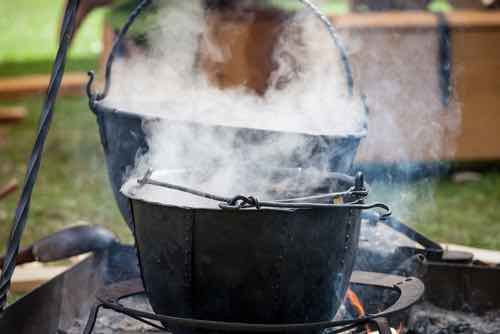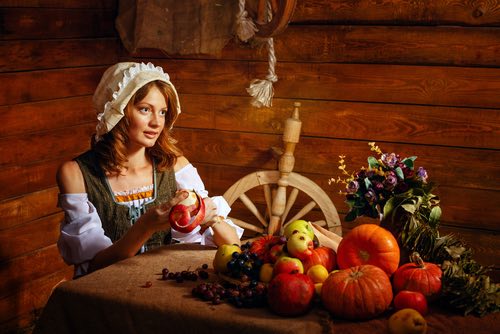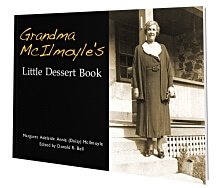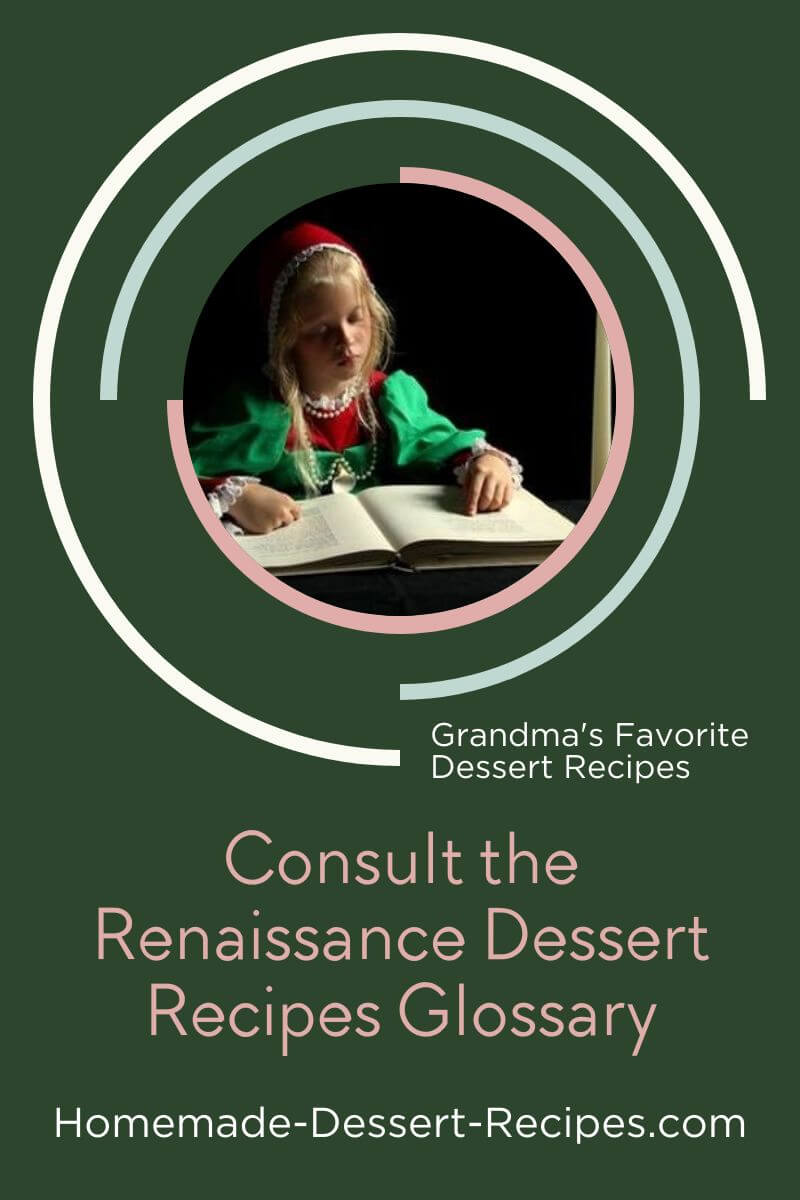- Home
- Renaissance Desserts
- Renaissance Dessert Recipes Glossary
Renaissance Dessert Recipes Glossary
This Renaissance Dessert Recipes Glossary is designed to help you understand any of the outdated ingredient names or cooking terms that you might find used in historical British recipes. You'll find it very helpful when reading the Medieval, Elizabethan, and Renaissance food recipes that appear exactly as first published.
Help with Historical Cooking Terms
 Consult the Renaissance Dessert Recipes Glossary
Consult the Renaissance Dessert Recipes Glossary(©Hallgerd/123RF Stock Photo)
How to Read Renaissance Recipes
The Glossary will not only assist you in understanding the period recipes, but you will enjoy reading it too. This glossary of Renaissance cooking terms may also shed light on some of the Old English words you have likely encountered in your casual, everyday reading.
The Renaissance dessert recipes featured on this website are carefully presented as they were first published in the mid 1600s. You get to read them as they actually appear in the Renaissance cookbooks.
 Long-S
Long-SThe historic food recipes are relatively easy to follow, but the appearance of what looks like the letter f in some words might seem rather strange.
In the Early-Modern-English style of writing, it was the practice to use a "long-s" character, which has the "appearance" of the letter f with a half-crossbar on the left-hand side. However, not all computer fonts display the ſ (long-s) character the same.
For example, Arial, the main font used on this site, omits the half-crossbar.
So, if you are unsure of a word, simply substitute an "s" for the ſ until the word makes sense. After you read a few recipes, you will be amazed at how natural it all becomes. The early style of writing is remarkably easy to understand after a little practice.
Renaissance Dessert Recipes Glossary
©2004 by Don Bell
 Renaissance Cooking Over an Open Fire
Renaissance Cooking Over an Open Fire(Source: ©Juhku/Depositphotos.com)
Ambergreece
Ambergris is an organic substance produced in the sperm whale and found floating in the sea or in the intestines of dead whales. The "greece" refers to the waxy texture and greyish color of the solid lumps, which possess a very sweet, earthy odor,
Ambergris was once much used in cookery, but its use went out of fashion, probably because it did not impart any significant taste; it was used mainly for the unique fragrance it imparted to the food. It was also used in the manufacture of perfume.
Ambergris may be safely omitted from recipes without leaving any noticeable difference in taste.
Baking pan
A covered pan that permitted hot coals to be heaped all around it to replicate in the hearth the function of an oven.
Barberry
An ornamental garden shrub (Berberis vulgaris) with a small, reddish, translucent fruit that was widely used to impart its sweet-sour flavor and brilliant color to many dessert dishes.
Billets of wood
Thick pieces of firewood.
Bisket
Biskets were not like the biscuits we now eat in North America. They were actually small sugar cakes or glazed sponge cakes, sometimes called confetti.
In ancient times, small sweetened cakes were crumbled over the heads of a wedding couple who were required to eat the crumbs for good fortune.
This "eating together," called confarreatio, is the origin of the word "confetti," which is now thrown at weddings and was once the term used for the tiny sugar biscuits.
Cake
Cakes in Elizabethan England and in the early years of the Renaissance were not like our modern-day cakes, but were similar to what we now call fruit breads.
They were breads sweetened with sugar or honey and filled with combinations of preserved fruit, nuts, seeds, and spices, and they were sometimes profusely decorated with comfits or simply glazed with sugar and white of egg.
Chaculato
A hot beverage flavored with shavings from solid chunks of a crudely refined chocolate that was unsweetened and had a somewhat bitter taste.
Charger
A Large, shallow dish.
Citron
The thick rinds of the citron fruit (Citrus medica) were often candied for use as a sweetmeat and for flavoring.
Clarified sugar
Refined sugar was seldom sold in its present-day granular form until the end of the 1800s. The sugar sold was often called loaf sugar, and it often had to be clarified before use by boiling it with water and white of egg to remove impurities.
Any of today's finely granulated sugars may be substituted in recipes without clarifying.
See my article on The History of Sugar for surprising information on the quantity of sugar used during the Medieval Era.
Cloſet, closet
A small storage room for curiosities, or a cook's pantry for utensils and provisions. For example, the "Queen-like Cloſet."
Cochinele
Cochineal is a powdered coloring matter yielding a brilliant scarlet dye; it consists of the dried bodies of the female Dactylopius coceus, an insect of tropical America and of Java. Tons of these insects were once harvested and used in making food colouring. Modern-day red food coloring may be substituted.
Coffins
Molds or coffin-shaped baking cases made of coarse pastry and used as a container when making various dishes, such as meat pies and cheesecakes. Though edible, they were rarely eaten, but simply used as a baking container for the non-solid ingredients.
Collops
Thin slices of anything, as in "collops of bacon."
Comfits, French comfits
Comfits were perhaps Medieval England's most popular sweetmeats. They consisted mostly of sugar-coated seeds that had been repeatedly "panned" or coated in boiling sugar up to two dozen or more times, until smooth and white.
Caraway, cardamom, coriander, celery, and aniseed were the most popular of the seeds used, but comfits were also made using almonds and dried fruits, like cherries, or berries, or tiny bits of ginger, nutmeg, cinnamon bark, and citrus peel.
Besides being enjoyed as a confection on their own, comfits were often used as edible decorations on other confections, such as marchpane, sweet tarts, cakes, biscuits, and puddings.
Conceits
Fancy, decadent sweetmeats, as in "some pretty conceits."
Conſerve
A sweetmeat in which fruits are preserved in sugar.
Cuſhion canvas
Coarse, canvas-like material once used as a sieve in cookery.
Currans
Currants.
Eringo root, eryngo root
The root of the sea holly, Eryngium maritimism. The candied roots were a popular confection in the 1600s and were once thought to be an aphrodisiac.
Fair
Fresh, clean, and pure, as in "a fair cloth" or "fair water."
Feathers
Goose wing feathers were sometimes used like a spatula to spread icing over a cake.
Flower
Ground grain or flour, which should not be confused with a plant's bloom because of the word's spelling.
Gallipot, gally-pot
Small earthenware pot or jar used for making preserves.
Gild
To cover or gild a surface with a very thin layer of edible gold (23-24 carats) that is laid on as gold leaf.
Ginger-bread
Once a highly prized confection, it was quite unlike today's gingerbread. It was more like a crisp, sweet candy and there were many variations, some of which contained absolutely no ginger at all.
It was often formed or molded (printed) in various shapes before being dried or baked. Some gingerbread was decorated with comfits and gilded with gold leaf before serving.
Green beets
Refers only to the green leaves (beet tops) of the beet vegetable.
Gum Arabick
Gum Arabic is a gummy substance obtained from trees of the Acacia family. It is commonly used as an emulsifier and thickener, and it helps to bind the ingredients. It also helps to stabilize the natural flavors.
Gum Arabic is sold in powder form at cake-decorating shops and at some homebrew stores and pharmacies. It should be thoroughly dissolved in water before adding to the recipe; you might find it easier to dissolve if you use a modern food blender. One of the small hand-held kitchen blenders would work very well.
After dissolving the gum Arabic, pour the liquid through a fine sieve before using. If refrigerated, dissolved gum Arabic can be kept in a sealed container for a couple of weeks.
Gum Dragon
Gum dragon was once a common name for gum tragacanth, which is a gummy substance obtained from spiny shrubs of the Astralagus family.
In its powder form it was once widely used in cookery similar to gum Arabic, but its use went somewhat out of fashion since it was only partially soluble in water and considered inferior to gum Arabic.
Some chefs say that for each ounce of gum dragon that a recipe calls for, you should use approximately four ounces of gum Arabic.
Gum Tragacanth
See Gum Dragon.
Iſinglaſs
"Isinglass" is a preparation of nearly pure gelatine made from the swim bladders of certain fishes, such as sturgeons, cod and carp. Present-day gelatin powder may be substituted in recipes.
Jordan almonds
Cultivated almonds. Their name is derived from the French word for garden (jardin) and not from the name of the Middle-Eastern nation.
Jumbals, jumbolds
Small sweetened cakes or biscuits formed into rings or knots with double loops, like pretzels.
Knots
The intertwining of pastry items, sweetmeats, and so on.
Lay
A layer of an ingredient, as in "a lay of sugar" or "a lay of fruit."
Leach
A popular medieval confection consisting of a thick, jelly-like preserve set hard enough to slice; it was often made using almonds and various fruit flavorings. Some leaches might have been similar to today's fruit leathers.
Lettice of wier, lettice wire
A sieve-like lattice made of crossed wires that was used to strain liquids.
Licoras
Licorice root.
Limon
Lemon fruit.
Lozenges
Sweetmeats composed of powdered sugar mixed with various fruit juices and spices, or even edible flower petals, made into a thick paste with dissolved gum Arabic or gum tragacanth.
The thick, jelly-like mass was then rolled into relatively thin sheets and either pressed into molds or cut into diamond shapes or any fancy shape desired. Some lozenges were brightly colored and translucent.
Manchet
Small loaves of quality bread weighing approximately one-half pound, which were made of the best wheat milled into the finest and whitest flour.
Marchpane
Marchpane or marzipan was a much-coveted sweetmeat consisting of almond paste sweetened with sugar. It was sometimes made into an elaborate confection by being moulded into three-dimensional shapes and hand-coloured to resemble artificial fruits, walnuts, and even slices of bacon.
Marchpane treats were at times gilded with an edible, pure gold leaf and served at special banquets by the nobility.
Marmalet
A fruit conserve similar to marmalade, but made much thicker and smoother than today's marmalades. More like a candy, this well-liked sweetmeat was stored in jars or boxes and was often cut into lozenge-sized pieces or a variety of fancy shapes for serving, such as diamonds, spades, clubs and hearts.
It was originally made of apples, but later cherries and apricots were used; oranges were not used for making marmalets until the latter part of the sixteenth century.
Musk
A strongly scented chocolate-colored substance obtained from the abdominal glands of the male musk deer. In its dried granular form, it was widely used in confectionery, but its use went out of fashion, probably because it did not impart any significant taste; it was used mainly for the strong fragrance it imparted to the food. Interestingly, a similar scent was identified in some plants, such as the muskmelon.
Oven as hot as for manchet
A moderately hot oven, about 375ºF.
Paſte
Fruit pastes were similar to leaches; they consisted of the pulp of various fruits reduced by heat to a kind of thick marmalade with the addition of, in some cases, up to nearly double the fruit's weight in sugar.
The paste was boiled to reach the preferred consistence and then molded into rings or knots, dried, and then either left plain or sometimes they were crystallized or candied. Pastes were very sweet confections, and they were often used to ornament the tops of cakes.
The term "paſte" can also refer to various pastries, such as puff paste.
Pap
The pulp of the fruit, or anything having a soft consistency.
Pies
Medieval dessert pies often contained wine, herbs, almonds, dried fruits, and even minced or thickly sliced meats. They were somewhat smaller and chewier than today's pies, spiced, highly sweetened with sugar or honey, and sometimes thickened with almond milk while baking.
Pie crusts were often crimped around the edges and for festive occasions, the top crusts were decorated with comfits and had flavored sugars strewn over them. Violet and rose sugars were the favorites and were colored.
Sometimes their top crusts were glazed with sugar and white of egg and, occasionally, gilded with a thin, edible gold leaf when served at royal banquets.
Pill
Peel, as in citron or "orange pills."
Pippins
Fruit of any tree grown from a seed, as opposed to grafting; however, the term was used most often of sweet dessert apples.
 Preparing Pippins (Apples) and Pumpions (Pumpkins)
Preparing Pippins (Apples) and Pumpions (Pumpkins)(Source: ©Vagengeym/Depositphotos.com)
Pipps
The pips or seeds of a pear or apple, etc.
Plate, as in Sugar Plate
A moldable sugar paste made of white sugar thickened with gum tragacanth that hardens in a manner similar to confectioner's icing.
Poſnet
Posnets were three-legged metal cooking pots sometimes known as porringers.
To mold or shape, as in "print it in a mold."
Pumpion, pompion
Pumpkin vegetable.
Quartern
A quarter of anything, as in "a quartern of almonds."
Roſewater, roſe-water
An essence distilled from fragrant rose petals and still used in Balkan, Middle Eastern, and Indian cookery in sweet dishes and cakes. It is sprinkled over desserts and fresh fruit and used as a mild flavoring.
Rose water is most famous for its use in Turkish Delight candy. In Elizabethan times, tons of roses were harvested each year, and the petals collected for distillation. Rose water is still sold at some specialty food stores.
While exploring the Suq in the old Muslim Quarter of Jerusalem, I once purchased some authentic Turkish Delight from an Arab confectioner.
The generous-sized cubes of jelly-like candy were coated with powdered sugar and wrapped in a white tissue-like paper.
It tasted sweet and was quite unlike anything you can buy in the stores at home. It was truly delicious, and I often wondered whether it was the subtle hint of rose water that made its taste so extraordinary.
Roots
Refers to the root vegetables, such as potatoes, beets, and carrots.
Roul, roule, rowl
To roll with a rolling pin, as in "roul them out thin."
Sack
A dry, amber wine imported from Spain or the Canary Islands that was fortified in the manner of sherry and usually drank sweetened with generous amounts of sugar or honey.
Saffron
The dried, deep-orange-colored stigmas of an autumn-flowering species of crocus (Crocus sativus) were used for coloring and flavoring confectionery and other foods.
Saunders, red saunders
A red dye imported from the Orient, which was obtained from the red sandalwood tree.
ſearced, ſearſed
Sifted or strained.
ſeething
Boiling or bubbling, as in "ſeething water."
Spinage
Spinach vegetable.
Spur
A sharp knife-like utensil used to cut pastry.
Suckets
Suckets consisted of bits of candied root, prunes, raisins, berries, or the peels of citrus fruits that were often spiced. When preserved and served in a thick sugar syrup, they were known as "wet suckets," and when first crystallized in boiling sugar syrup and then coated in powdered sugar, they were known as "dry suckets."
Suckets were a natured confection to suck on; hence, their name; they were commonly used to sweeten the breath.
Sweet-Meat, sweetmeats
The term "sweetmeat" encompassed almost any sweetened food item, including fruits, candied fruits and conserves, sugared nuts, sugar candies, cakes, pies, tarts, leaches, and sugar paste molded into fancy shapes.
Ingredients like ginger, nutmeg, cloves, aniseed, coriander, almond, saffron, rose water, and sack (sherry) were often used as flavorers for sweetmeats. Vanilla and coffee flavors were unavailable in England before the Renaissance Era.
Tanſie
Tansie is a custard-like dessert dish made similar to a pancake and flavored with fruit or even flower blossoms. Some tansies were colored green using spinach juice. And some were flavored with the bitter herb tansy and served at Easter.
Tart
Tarts and the much smaller sweet tarts, sometimes called chewettes, were usually made without an upper crust, as distinguished from a pie, and they often contained preserved fruits, almonds, citrus peel and even minced meats.
Renaissance tarts were richer and chewier than today's tarts, spiced, highly sweetened with sugar or honey, and sometimes thickened with almond milk while baking.
Crusts were crimped around the edges and for festive occasions, they were decorated with comfits and had flavored sugars strewn over them. Violet and rose sugars were the favorites and were colored, accordingly.
Tornſel, turnſole
Turnsole refers to any plant that turns its flowers toward the sun, such as the heliotrope; it gives a reddish dye when its flowers are ground in a mortar with lemon juice.
A French lichen was also dried and used as a coloring agent, and, like the heliotrope, it gave a red color to foods containing an acid and a blue color to foods containing an alkaline. Modern-day food coloring may be substituted.
Trencher
A thick slice of stale bread cut from a large oblong loaf was used as a simple plate in medieval times; it was called a trencher after the Old French word "trencher," to slice. The bread itself was often eaten at the end of the meal.
Sometimes, the gravy-soaked trenchers from the master's table were distributed to feed the poor on the estate.
In the fourteenth century, rectangular plates made of wood or pewter, also called trenchers, began to be used to support the bread. Eventually, the wooden trenchers supplanted the use of bread by the middle of the sixteenth century.
Tun
To store a beverage in a cask or tun.
Verjuice
A sour-tasting, fermented, vinegar-like juice made from the juice of unripe grapes, and later from the juice of crab apples.
Walm
A medieval term used for a boiling-up, as in "let them boil a walm or two."
Wier
Metal wire, as in "round wiers."
NEW WORDS will be added to the Renaissance Dessert Recipes Glossary as new recipes are added to this site, so be sure to bookmark this page and check back often. I hope you'll find this glossary of Renaissance cooking terms helpful.

Gum Dragon and 23kt edible Gold Leaf are not easy to find locally, so here's where to get the historical ingredients called for in some Renaissance recipes.

Sign Up now for GRANDMA'S DESSERT CLUB and download your FREE PDF COPY of Grandma McIlmoyle's Little Dessert Book. Also receive my regular Bulletin featuring classic recipes and nostalgia.


